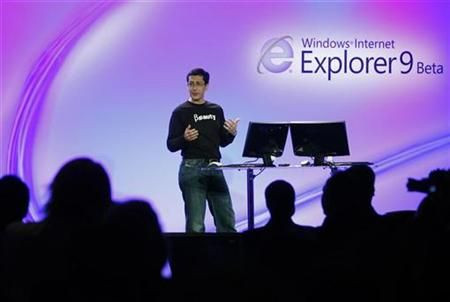Microsoft Unveils IE9 Release Candidate

Software giant Microsoft (Nasdaq: MSFT) launched the release candidate (RC) of Internet Explorer 9 (IE9) with enhanced privacy features.
The release candidate is nothing but the last testing phase before a browser is released in its final form.
The Redmond, Washington-based Microsoft said the RC version of IE9 is available in 40 languages and it claims that the product has made progress on all fronts, including performance and standards, user experience, and safety and privacy.
With the Release Candidate, we've taken to heart over 17,000 pieces of feedback about IE9, Dean Hachamovitch, Corporate Vice President, Internet Explorer, said in a blog post.
The IE9 RC is faster with real world sites and a user will find that Gmail, Office Web Applications, and many other sites are faster as a result of scenario tuning, network cache tuning, and new compiler optimizations.
You'll also find that the RC of IE9 often uses megabytes less memory than the beta because of changes like delayed image decoding. We've also improved the performance of things many people do every day, like find on page, and made improvements which extend battery life, the blog post said.
IE9 RC supports additional emerging Web standards including CSS3 2D Transforms, HTML5 Geolocation and a set of HTML5 semantic elements. It also provides accessibility to the HTML5 audio and video controls, allowing developers to experiment with new and emerging specifications through Microsoft's HTML5 Labs.
With this Release Candidate we've added over a thousand new test cases for JavaScript and updated over fifty test cases based on community feedback. During IE9 development we have now submitted just under 4000 test cases in total for standards like HTML5, the blog post said.
On the security front, IE9 now includes Tracking Protection, whcih enables users to express their preference for privacy, and also gives them a mechanism to enforce specific aspects of that preference.
Users can do this by choosing Tracking Protection Lists from organizations they trust. These lists can block and allow third-party content in order to control what information users share with sites as they browse the Web.
By controlling the flow of information to sites, these Tracking Protection Lists help users protect their privacy. Unlike other solutions, IE9's benefits users even if Web sites do not respect the user's preference to not be tracked. The ability for a site to determine that the user has expressed a desire to not be tracked (by turning the feature on) is inherent in the design of Tracking Protection, the blog post said.
Meanwhile, the New Tab page has been revamped in IE9 to display the websites that users visit most, so that navigation is simple and easy. Each site's icon and primary color is used on the New Tab page to help a user identify sites more easily.
Also, a site indicator shows if the site is visited often or not. From the New Tab page, one can also reopen closed tabs, reopen the last browser session, clear the site indicators, or start InPrivate® Browsing.
In addition, IE9's download manager will now display the download speed, and download notifications are animated and more noticeable.
In IE9, a user can pin down his favorite websites that can be accessed directly from the Windows taskbar without having to first open the browser. Pinned sites now support multiple home pages.
Microsoft debuted IE9 last March and unveiled a public beta version in September 2010. Over 25 million copies of IE9 beta version have been downloaded to date, Microsoft claims.
Following is a cheat sheet from the IE engineering team hallway for what's new in the RC:
Additions to IE9 between Beta and RC | |||
Performance | Standards & Platform | User Experience | Trustworthy Browsing |
Elapsed Time Significant scenario tuningChakra performance optimizationsNetwork cache improvements (size, priorities, etc.)Compiler optimizations and binary training Large Working Set Reductions Delayed image decoding (1-50MB depending on site) Reduce memory footprint of InPrivate Filtering heuristic generation (5MB) Binary size reductions (over 1MB saved) Other Real-World Decrease timer resolutions to 4ms from system default of 15.6ms Timer resolution aware of Power Options Find on Page performance | CSS CSS3 2D Transforms DOM HTML5 Geolocation API HTML5 semantic elements Allow alternative video codec (WebM) Accessibility of media controls Compatibility View List Software fallback list for GPU/drivers in XML CV list F12 console logs for CV sites and support for Tracking Protection | Tabs Optional full tab rowClose box for inactive tabsMore identifiable active tab Frame Paste & navigate (Ctrl+Shift+L)Refine search queries in onebox Reduced frame pixels Better favorites bar integration Menu bar toggle Intranet search by default option Notifications Display download speed Auto dismiss notifications Animated downloads notifications Improved app reputation notifications Pinned Sites Pin to vertical task bar Multiple home pages in pinned site In-page drag-to-pin support | Tracking Protection ActiveX Filtering InPrivate InPrivate pinned sites |
© Copyright IBTimes 2025. All rights reserved.




















